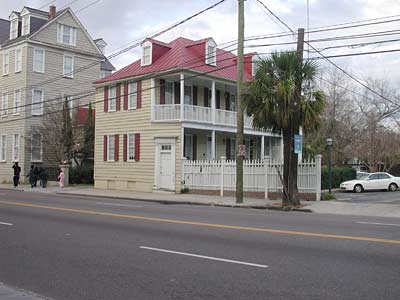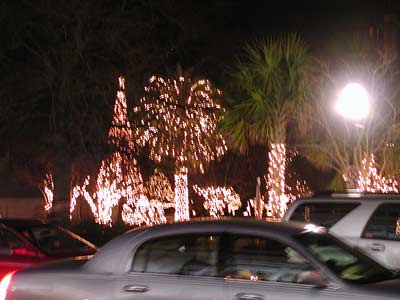We drove to Charleston, stopping to walk at a county park called the Caw Caw Interpretive Center. It had some nice trails and a very interesting exhibit about growing rice.
It turns out that rice growing is all about hydraulics, or at least about moving water. It also turns out that West Africa was one of the places where rice has been grown for centuries. Guess where the know-how for the Carolina rice industry came from? Caw Caw park has a network of (long abandoned) ditches which were managed to flood and drain rice fields according to the plants’ seasonal requirements. The field has to be flooded when the rice is planted, then drained, then flooded again, drained again, and flooded once more before harvest. The visitor center exhibit had a model of a ditch control gate, a rectangular wooden culvert that had paddles suspended from an overhead frame to close it off at each end, depending on which way you wanted the water to go. Water pressure on the outside would push a paddle against the culvert, preventing water from flowing in from that side. The paddle on the side from which you wanted water to come could be raised by levers inserted into a series of holes on the paddle’s handle, so you slid the paddle along the front of the culvert rather than trying to push against the water pressure. This is just my science background and basic nerdiness coming out — I spent a while studying the model and talking with the woman running the visitor center, trying to figure it all out.
We walked around Charleston. There’s a big visitor center for the whole city, with a parking garage. The city is small enough that we figured we could walk all around, and we did, but there are trolley tours and shuttles for people who don’t want to walk as much as we do. There were cars from all over the country in the garage.
To minimize the amount of street frontage that houses took up (thus cutting down on the tax assessment) early Charleston houses were built with the side to the street and the front door on the side, still having those big second-story porches that I think of as southern architecture. This was the first one of those that we saw. Kind of strange? At least distinctive. The door on the street isn’t the front door, just the door to the yard and the porch. In other sections of the city the houses like that are separated from the next one just by the width of a driveway.

This is the front of the oldest theatre in Charleston. It’s famous for having the bar where Planter’s Punch was invented. How about that wrought iron. Did you think the French Quarter of New Orleans was the only place with that kind of thing? There’s plenty of it in Charleston.

On our way from the parking garage to the sections of the city with the old houses we noticed a restaurant, Jestine’s Kitchen, that seemed to have lots of regional food and looked like the level of place, and the price range, that we were interested in. When we came back it was full, with a short line waiting outside. We were seated after a little while, and yes, it was just what we had been looking for. I got pecan-crusted fried chicken with side dishes of field peas and fried okra. Arlene shared her side of collard greens with me, and we swapped some stewed okra for some of the fried. There was no sweet potato pie on the dessert menu, but there was pecan pie, with a thick layer of chopped pecans on top rather than one or two pecan halves.
Besides great regional food, Jestine’s big idiosyncracy is its collection of chinaware salt and pepper shakers. Every table has a different set, and counters around the room have dozens more pairs on display. It seems as though it’s a tradition for regular customers to send a pair of salt and pepper shakers to the restaurant from wherever they travel.
Oh, and did you ever wonder about those Corona Beer commercials showing Christmas lights on palm trees? I guess that’s real, because even in Charleston you can see them.
